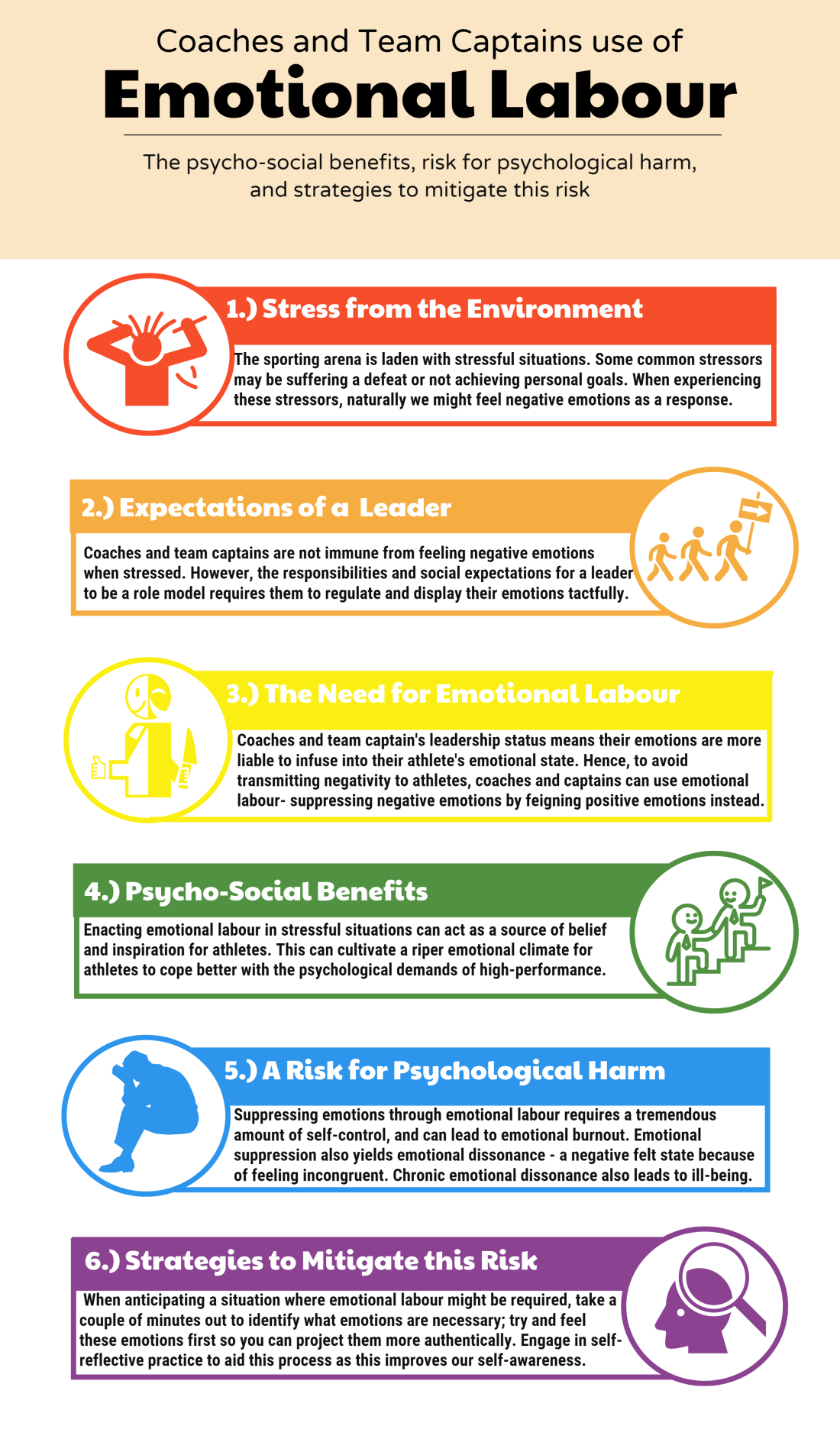
Introduction
The fluidity of experiencing strong positive and negative emotions is ever-present in the sporting arena as the margins for success or failure are often within a hair’s breadth. Certainly, long gone are the days of great man theories, where leaders were thought of as those with superior personality traits such as charisma and resilience. Nowadays it is recognised that how well coaches navigate through the treacherous landscape of the sporting arena is down to the psychological strategies they employ. Thus, coaches are no more immune from experiencing strong negative emotions than their athletes. For the sake of their athletes, however, coaches are often expected to ‘walk on water’ – a reference to the biblical passage of Mathew 14-22-33, where Jesus is said to have demonstrated godlike ability by walking on the sea of Galilee to calm his disciples — by expressing an unshakable aura of confidence in times of duress.
What is Emotional Labour?
This ‘greenhouse effect’ coaches attempt to produce has been coined by Hochschild (1983) as Emotional Labour. Hochschild defined emotional labour as the requirement of “one to induce or suppress feelings in order to sustain the outwards countenance that produces proper states of mind in others” (1983, p.7). As Hochschild explains, once we represent an institute we are obliged to display the emotions that are necessary to deliver their service. This led Hoschschild to recognise that a regular practice of people in work settings is to manufacture their emotions to meet ‘display rules’ of the job. Two strategies can be used to do this. Surface acting would incur a coach to suppress felt emotions (i.e., anxiety) to falsely display the required emotions (i.e., confidence) they believe is needed to benefit their athlete. On the other hand, deep acting would involve a coach exerting effort into actually feeling this confidence, therefore spontaneously exuding it to the athlete (Hochschild, 1983).
From interviewing elite level coaches, Thelwell, Westan, Greenlees, and Hutchings (2008) levelled that given coaches often employed many psychological skills (i.e., imagery) for the primary purpose to conceal their negative emotions through feigning positive emotions to their athlete (surface acting), they are “performers” (p.38) in their own right. However, perhaps anyone placed in a position of leadership is a ‘performer’. For instance, Friesen, Devonport, Sellars, and Lane (2013) found that Ice Hockey captains vigilantly assessed their own and their fellow athlete’s emotions; using this diagnosis to only filter through emotions that they believe would benefit their fellow athletes (i.e., calm) and abide by the expectations of a captain’s role (i.e., to lead by example). Quite fittingly, then, are the words of Former British Prime Minister Winston Churchill who said: “Where there is great power there is great responsibility“ (Parliamentary debates, 1906, p. 1239). It seems the social capital that is ascribed to a leader whether they be a coach or team captain does seem to breed a sense of responsibility on their behalf to ensure their emotions are ripe for their athletes.
In their extensive review of 20 years’ worth of theory and research investigating the effects of business leaders emotions in the workplace, Gooty, Connelly, Griffth, and Gupta (2010) concluded on a clear finding: a leader’s positive mood unconsciously infuses itself into their follower’s emotional state, producing favourable outcomes for both parties (leader and follower), such as creating a shared identity, a more optimistic vision of the future, and developing better quality relationships. On the contrary, a leader’s negative mood is, by and large, detrimental to their effectiveness and transmits into poorer workplace productivity. Armed with such a strong finding, coaches and captains perhaps have a unique opportunity to improve their athlete’s mindset through using emotional labour strategies (surface and deep acting).
Is Emotional Labour Important in Sport?
However, one could be excused for questioning whether this evidence found in the business domain can translate into the sports setting. To answer this valid question, one avenue can be to assess the effect of coach’s and captain’s positive emotions on athlete outcomes. Tamminen et al. (2016) interviewed 14 university athletes about their own, and their teams use of emotions within the sporting environment. The athletes consistently spoke of the importance the coach or captain’s emotional display had on the team as it set the ‘emotional tone’ for the group. Athletes elaborated on this point by stating that when coaches or captains expressed positivity during stressful times (I.e., suffering a defeat), this helped mitigate the stress athletes felt from their performance.
In another study by Tamminen and Crocker (2013), interviews were carried out with a high-performance Curler team over the course of their season. What emerged from the data was consistent with, and adds to the findings of the previous study. The captain spoke at length about having a responsibility to project neutral or positive emotions to conceal negative emotions (surface acting) that she felt would poorly affect her teammates. This use of surface acting seemed to reap many benefits for the team during competitions, with athletes particularly highlighting how the captain became a source of inspiration that helped them to reappraise the performance arena more positively. Hence, these anecdotal accounts from athletes suggest when leaders radiate positivity in the sporting arena — especially in times of duress — through emotional labour strategies, both parties tend to derive many psychological benefits.
Another attempt to conclude if emotional labour is an effective strategy in sport is to perhaps observe if highly successful coaches engage in emotional labour. A study by Lara-Bercial and Mallet (2016) is the most recent publication to come out of the serial winning coach project which aimed at understanding the psychological attributes amongst other things, that made-up seventeen of the world’s most successful performance coaches. Between them, this special cohort of coaches had accumulated 160 Olympic gold medals/major championship titles in their careers. For these coaches, it was imperative for them to be a source of belief for their athletes. Engendering this belief was conceived as best achieved by persuading the athletes of their capability through leading by example with their emotional display (i.e., remaining calm under pressure). Moreover, of utmost importance to these coaches was to use emotional labour to produce behaviours that would cultivate a stable and dependable optimal sporting environment (i.e., motivational climate) to allow their athletes to flourish.
Similar to the previous study, Olusoga, Maynard, Hays, and Butt (2011) were interested in understanding the core psychological attributes that coaches felt was vital for successfully performing on the Olympic stage. To investigate this interest, eight coaches from one of Great Britain’s most successful Olympic team were interviewed. Indeed, the strongest and most recurring psychological attribute for Olympic success discussed by coaches was the ability to control their emotions and to display certain emotions tactically to benefit their athletes. Again, emotional labour was viewed as essential in “optimising the environment for the athlete” (p. 5) and to project an “aura of confidence” (p. 4) to keep athletes believing in the coach’s capabilities to bring about success.
What stands out from these studies, is when operating within the pressure-cooker environment of high performance, athletes, coaches and captains all believe the need to exude positivity (i.e., calm) through verbal (i.e., emotional tone of speech) and non-verbal (i.e., body language) communication cues is imperative to being successful; mirroring the findings from the business domain (Gooty et al., 2010). For coaches and captains, enacting emotional labour perhaps reimburses them with greater social capital, affording them more liking, trust and respect from their athletes, and a greater capacity to influence their athlete’s psyche. For athletes, coach or captain’s emotional labour likely cultivates a riper environmental climate for the athlete to maximise their performance potential, and help them to respond better to stressors within their environment (i.e., aspiring to behave like the captain).
Is Emotional Labour Psychologically Harmful?
Put simply; humans were not designed to project emotions they do not actually feel, and this has consequences for our health. In a song called “walk on water” by rapper Eminem, he remarks “Kids look to me as a god, this is retarded, if only they knew, it’s a façade and it’s exhaustive”. As Eminem alludes to in these verses, his failure to truly believe in this ascribed godlike status from his fans leads him to feign an aura of self-assurance which is incredibly taxing. The psychologically taxing nature of Eminem’s situation is what is referred to within the literature as emotional dissonance — “a perceived emotional state [typically negative] representing the dissonance between felt emotions, and emotions that is perceived to be required” (Rubin, Tardino, Daus, & Munz, 2005, p.192). It is well documented that emotional labour, especially surface acting, leads to emotional dissonance. This is important because the more significant the emotional dissonance we incur from using emotional labour, the more psychologically harmful this will likely be to our well-being (Rubin et al., 2005).
Secrecy is defined as “an intention to conceal information from one or more individuals” (Slepian, Chun & Mason, 2017, p.2). Hence, emotional labour, or more specifically surface acting, is perhaps analogous to keeping a secret. In a series of studies by Slepian and his colleagues, it was found unequivocally that keeping a secret was harmful to our physical and psychological well-being. Poorer well-being that festers through keeping secrets seems to occur because of the amount of time we spend stewing on concealing information from other people, making us feel as if we are behaving incongruent from our true self (emotional dissonance). Indeed, Ryff and Singer (2008) extensively reviewed the concept of well-being, concluding that it can be collapsed into two parts: our degree of happiness (hedonic), and the extent to which we feel we are living a meaningful existence by acting in accordance with our core values and beliefs (eudaimonia). Ryff and Singer went on to explicitly state that we cannot have one without the other. In other words, experiencing dissonance is likely to thwart our eudaimonia well-being, leading to unhappiness as we are not at one with ourselves.
Another adverse side effect that stems from emotional labour is the need to exert a considerable amount of self-control. When engaging in surface acting, we exert tremendous psychological effort to suppress our felt emotions, and instead, project feign emotions. In a study with 430 coaches from 21 different sports, Lee and Chelladurai (2016) found that the more coaches used surface acting, the greater was their emotional exhaustion. Deep acting, however, did not lead to emotional exhaustion in the coaches. Perhaps this is a logical finding, given deep acting requires a coach to feel the required emotions before projecting them. Therefore, there is bound to be little emotional dissonance when engaging in this form of emotional labour.
Can the Psychological Harm from Emotional Labour be Mitigated?
Pragmatically speaking, it would be inappropriate to advise coaches and captains to stop using emotional labour. The consequences of being candid with their athletes about their negative emotions might be beneficial in some situations. However, for the most part, it can lead to a host of undesired outcomes for both parties (Thelwell, Wagstaff, Rayner, Chapman, & Barker, 2016). Fortunately, research is afoot to understand how to counteract the psychological harm of emotional labour. Increasing coaches and captain’s emotional intelligence — developing a greater self-awareness of one’s feelings, and understanding how one’s emotions may influence the environment— appears to be a promising strategy at mitigating the psychological cost of emotional labour. Lee and Chelladurai (2016) found the more emotionally intelligent a coach was, the less likely they were to suffer from emotional exhaustion when engaging in surface acting. It is thought that an astute self-awareness of one’s own emotions affords the coach the ability to understand why they suppress certain emotions. Such an understanding may reduce the amount of emotional dissonance felt, as coaches can become more knowledgeable and self-accepting; levelling that emotional labour is not necessarily being inauthentic, but purposeful for enhancing their athlete’s performance.
Another advantage of increasing emotional intelligence is it can promote the use of deep acting instead of surface acting. As previously mentioned, deep acting incurs little emotional dissonance as it involves feeling the required emotions before projecting them. Recently, Edelman and Knippenberg (2017) successfully increased business leader’s deep acting through a 3-hour workshop. One tip from this workshop is to use what is known as implementation intentions. When anticipating a difficult situation (i.e., about to address the athletes after a defeat), take a couple of minutes away from everyone. In this time, reflect on what enactment of emotions are necessary to achieve your goals in this upcoming situation. This self-reflection should help you to be better prepared for the situation, and better project the emotions you intend to display. On a final note, self-reflection is also key to increasing our emotional intelligence. A good way to do this is to think of a recent emotionally charged event and ask yourself the following questions: How did I feel in this situation? How did others feel in this situation? Where did my emotions come from? What were the consequences of my emotions? The better you become at answering these questions, the better you can develop self-awareness of your emotions — the more likely you are to mitigate psychological harm attached to engaging in emotional labour.
References
Edelman, P. J., & van Knippenberg, D. (2017). Training leader emotion regulation and leadership effectiveness. Journal of Business and Psychology, 32(6), 747-757. doi:10.1007/s10869-016-9471-8
Friesen, A. P., Devonport, T. J., Sellars, C. N., & Lane, A. M. (2013). A narrative account of decision-making and interpersonal emotion regulation using a social-functional approach to emotions. International Journal of Sport and Exercise Psychology, 11(2), 203-214. doi:10.1080/1612197X.2013.773664
Gooty, J., Connelly, S., Griffith, J., & Gupta, A. (2010). Leadership, affect and emotions: A state of the science review. The Leadership Quarterly, 21(6), 979-1004. doi:10.1016/j.leaqua.2010.10.005
Great Britain Parliament. (1906). The parliamentary debates. London, England: Reuter’s Telegram Co.
Lara-Bercial, S., & Mallett, C. J. (2016). The practices and developmental pathways of professional and olympic serial winning coaches. International Sport Coaching Journal, 3(3), 221-239. doi:10.1123/iscj.2016-0083
Lee, Y. H., & Chelladurai, P. (2016). Affectivity, emotional labor, emotional exhaustion, and emotional intelligence in coaching. Journal of Applied Sport Psychology, 28(2), 170-184. doi:10.1080/10413200.2015.1092481
Olusoga, P., Maynard, I., Hays, K., & Butt, J. (2012). Coaching under pressure: A study of olympic coaches. Journal of Sports Sciences, 30(3), 229-239. doi:10.1080/02640414.2011.639384.
Rubin, R. S., Tardino, V. M. S., Daus, C. S., & Munz, D. C. (2005). A reconceptualization of the emotional labor construct: On the development of an integrated theory of perceived emotional dissonance and emotional labor. In C. E. Härtel, W. J. Zerbe & Ashkanasy N. M. (Eds.), Emotions in organizational behavior (pp. 189-211). Mahwah, NJ: Lawrence Erlbaum Associates.
Hochschild A. R. (1983). The managed heart: Commercialization of human feeling. London, England: Berkeley: University of California Press.
Ryff, C. D., & Singer, B. H. (2013). Know thyself and become what you are: A eudaimonic approach to psychological well-being. Journal of Happiness Studies, 9(13), 13-39. doi:10.1007/s10902-006-9019-0
Slepian, M. L., Chun, J. S., & Mason, M. F. (2017). The experience of secrecy. Journal of Personality and Social Psychology, 113(1), 1-33. doi:10.1037/pspa0000085
Tamminen, K. A., Palmateer, T. M., Denton, M., Sabiston, C., Crocker, P. R. E., Eys, M., & Smith, B. (2016). Exploring emotions as social phenomena among canadian varsity athletes. Psychology of Sport and Exercise, 27, 28-38. doi:10.1016/j.psychsport.2016.07.010
Tamminen, K. A., & Crocker, P. R. (2013). “I control my own emotions for the sake of the team”: Emotional self-regulation and interpersonal emotion regulation among female high-performance curlers. Psychology of Sport and Exercise, 14(5), 737-747. doi:10.1016/j.psychsport.2013.05.002
Thelwell, R. C., Wagstaff, C. R. D., Rayner, A., Chapman, M., & Barker, J. (2016). Exploring athletes’ perceptions of coach stress in elite sport environments. Journal of Sports Sciences, 35(1), 44-55. doi:10.1080/02640414.2016.1154979
Thelwell, R. C., Weston, N. J., Greenlees, I. A., & Hutchings, N. V. (2008). A qualitative exploration of psychological-skills use in coaches. The Sport Psychologist, 22(1), 38-53. doi:10.1123/tsp.22.1.38
Advertisements Share this:





